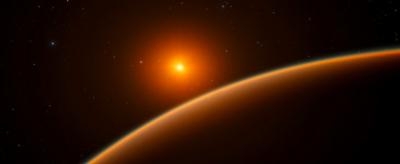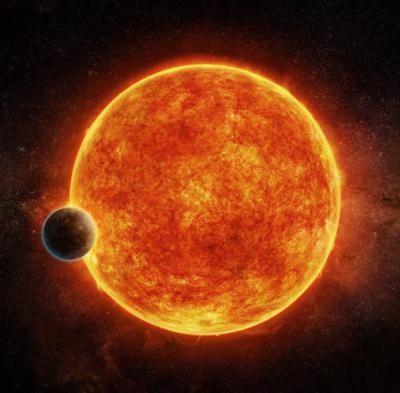Transiting Rocky Super-Earth Found In Habitable Zone Of Quiet Red Dwarf Star
An exoplanet orbiting a red dwarf star 40 light-years from Earth may be the new holder of the title “best place to look for signs of life beyond the Solar System”. Using ESO’s (European Southern Observatory) HARPS instrument at La Silla, and other telescopes around the world, an international team of astronomers discovered a “super-Earth” orbiting in the habitable zone around the faint star LHS 1140. This world is a little larger and much more massive than the Earth and has likely retained most of its atmosphere. This, along with the fact that it passes in front of its parent star as it orbits, makes it one of the most exciting future targets for atmospheric studies. The results will appear in the April 20, 2017 issue of the journal Nature.

The newly discovered super-Earth LHS 1140b orbits in the habitable zone around a faint red dwarf star, named LHS 1140, in the constellation of Cetus (The Sea Monster). Red dwarfs are much smaller and cooler than the Sun and, although LHS 1140b is ten times closer to its star than the Earth is to the Sun, it only receives about half as much sunlight from its star as the Earth and lies in the middle of the habitable zone. The orbit is seen almost edge-on from Earth and as the exoplanet passes in front of the star once per orbit it blocks a little of its light every 25 days.
“This is the most exciting exoplanet I’ve seen in the past decade,” said lead author Jason Dittmann of the Harvard-Smithsonian Center for Astrophysics (Cambridge, USA). “We could hardly hope for a better target to perform one of the biggest quests in science — searching for evidence of life beyond Earth.”
"The present conditions of the red dwarf are particularly favourable — LHS 1140 spins more slowly and emits less high-energy radiation than other similar low-mass stars," explains team member Nicola Astudillo-Defru from Geneva Observatory, Switzerland.
For life as we know it to exist, a planet must have liquid surface water and retain an atmosphere. When red dwarf stars are young, they are known to emit radiation that can be damaging for the atmospheres of the planets that orbit them. In this case, the planet's large size means that a magma ocean could have existed on its surface for millions of years. This seething ocean of lava could feed steam into the atmosphere long after the star has calmed to its current, steady glow, replenishing the planet with water.

The discovery was initially made with the MEarth facility, which detected the first telltale, characteristic dips in light as the exoplanet passed in front of the star. ESO’s HARPS instrument, the High Accuracy Radial velocity Planet Searcher, then made crucial follow-up observations which confirmed the presence of the super-Earth. HARPS also helped pin down the orbital period and allowed the exoplanet’s mass and density to be deduced.
The astronomers estimate the age of the planet to be at least five billion years. They also deduced that it has a diameter 1.4 times larger than the Earth — almost 18 000 kilometres. But with a mass around seven times greater than the Earth, and hence a much higher density, it implies that the exoplanet is probably made of rock with a dense iron core.
This super-Earth may be the best candidate yet for future observations to study and characterise its atmosphere, if one exists. Two of the European members of the team, Xavier Delfosse and Xavier Bonfils both at the CNRS and IPAG in Grenoble, France, conclude: “The LHS 1140 system might prove to be an even more important target for the future characterisation of planets in the habitable zone than Proxima b or TRAPPIST-1. This has been a remarkable year for exoplanet discoveries!”.
In particular, observations coming up soon with the NASA/ESA Hubble Space Telescope will be able to assess exactly how much high-energy radiation is showered upon LHS 1140b, so that its capacity to support life can be further constrained.
Further into the future — when new telescopes like ESO’s Extremely Large Telescope are operating — it is likely that we will be able to make detailed observations of the atmospheres of exoplanets, and LHS 1140b is an exceptional candidate for such studies.
(Image provided with ESO news release)
 ANN's Daily Aero-Term (04.14.24): Maximum Authorized Altitude
ANN's Daily Aero-Term (04.14.24): Maximum Authorized Altitude ANN's Daily Aero-Linx (04.14.24)
ANN's Daily Aero-Linx (04.14.24) Classic Aero-TV: 'We're Surviving'-- Kyle Franklin Describes Airshow Life 2013
Classic Aero-TV: 'We're Surviving'-- Kyle Franklin Describes Airshow Life 2013 Aero-News: Quote of the Day (04.14.24)
Aero-News: Quote of the Day (04.14.24) Airborne 04.09.24: SnF24!, Piper-DeltaHawk!, Fisher Update, Junkers
Airborne 04.09.24: SnF24!, Piper-DeltaHawk!, Fisher Update, Junkers




